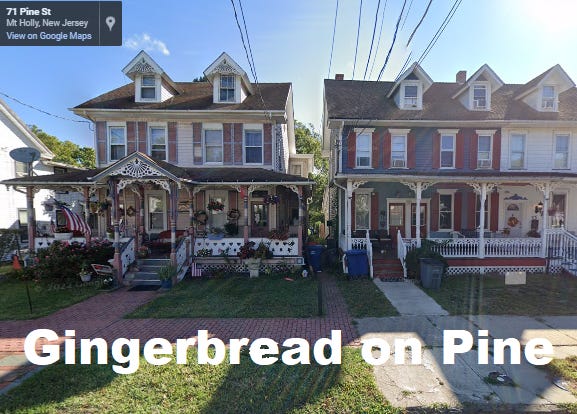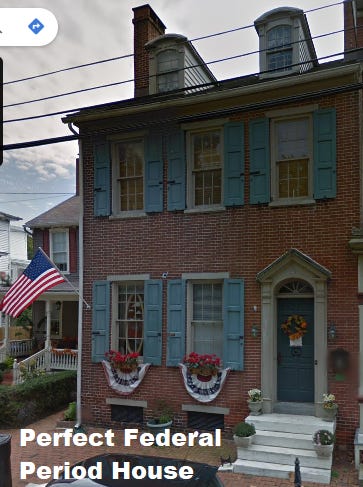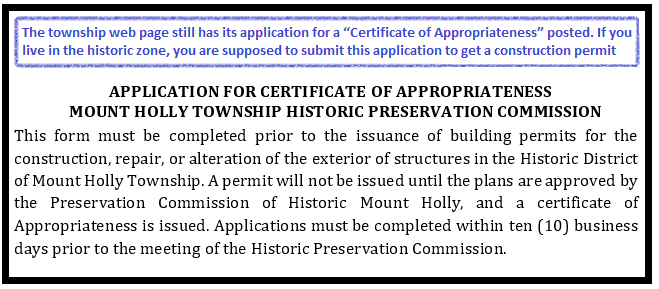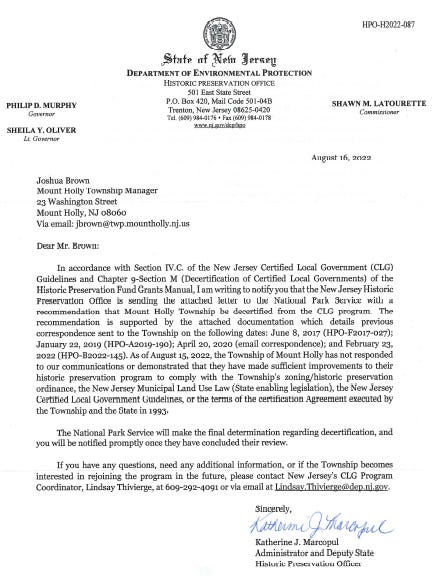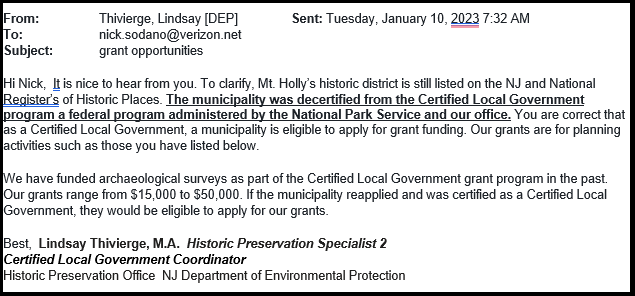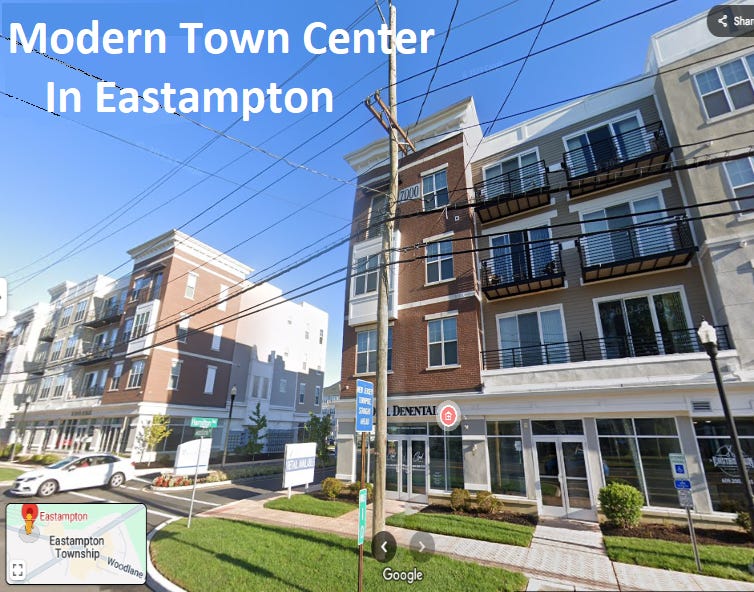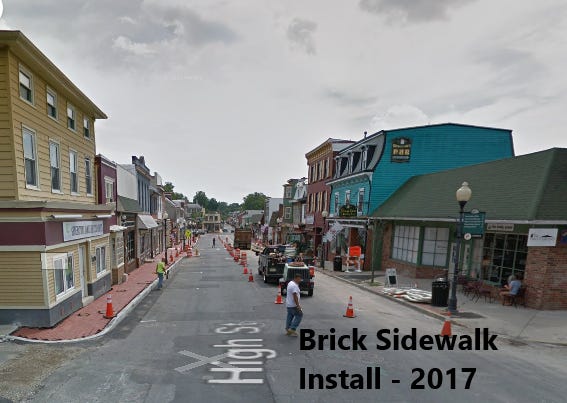Editorial: Going, Going, Gone!
THE SLOW EROSION OF HISTORIC MT HOLLY IS ABOUT TO ACCELERATE
Summary: Happy New Year Readers! Here is a long-simmering story about our sense of place in history and architectural heritage.
By Nick Sodano
WE HAVE GOOD BONES
My walks along different routes in town provide an informal survey of Mount Holly architecture. From lovely Gingerbread Victorians on Pine or High to the Federal Period homes on Garden and Brainerd, many great historic buildings in this town are maintained with love.
WHAT ERODES HISTORIC HERITAGE?
There has been a loss of historic detail over the decades as new renovation options caused a creeping erasure of architectural features.
“Raised seam” tin covered the original fire-prone cedar shake roofs. Then asphalt shingles replaced both types of roofing. Aluminum and asbestos siding covered cracked paint on wooden clapboard. More recently, vinyl siding has taken over. And everywhere, grey concrete replaced historic brick and bluestone sidewalks. Each innovation promised savings in money and maintenance. And as the new materials appeared, the history disappeared.
For example, my 1830 home on Garden Street suffered a wholesale erasure of its historical features. Acid from coal heat eroded the brick chimney, which collapsed with part of the wall sometime after 1911. The owners employed a modern fix that completely encapsulated the house in a shell of etched mortar that simulated stone blocks. Goodbye brick façade. To complete the transformation of my traditional “Federal Period” home, the owner removed its shutters and the old 6-over-6 windows. This created a kind of Greek Revival hybrid box. Other Federal Period houses in the neighborhood escaped intact, like 104 Garden Street which has a perfect brick façade, marble steps, 6-over-6 windows, and working 3-panel shutters.
I would love to renovate my façade back to its former glory but it would cost $15,000 just to replace the windows and shutters. I haven’t priced options for bringing back a brick façade. Because we are chipping away at the debt from successive renovations of our heating system, roof, water line, bathroom, and various paint jobs. No doubt, many neighbors who own historic houses struggle with the same budget issues that make historically accurate façades more of an aspiration than a practical priority.
WHAT ROLE DOES GOVERNMENT PLAY?
The government plays a leading role in preservation because the township issues building permits. Currently, those permits should not be issued unless a “Certificate of Appropriateness” is granted by a Historic Preservation Commission. Or at least that is what the application for the certificate says [see below]. And even though the Commission no longer has appointed members, the application is still on the Township website and the law can still be found at 149-165 of our municipal ordinances [See https://ecode360.com/MO1235 and search for Historic Preservation]
Truth be told, our municipal government decided after 2012 that it would dispense with historic preservation. It began when appointments to the Historic Preservation Commission [HPC] did not take place. Municipal officials claim they wanted to appoint but did not receive HPC applications from the community. This is a well-worn distraction tactic that points to apathy in the community instead of the township’s failure to mount a real recruitment effort.
Amy Eversmeyer knows all too well the disdain township administrators direct toward historic preservation. She served as Chair of the HPC until 2003.
“Our Commission was respected at the County and State level for our work in Mount Holly.”
Then came a dramatic dispute about a bank seeking to tear down two historic buildings on “lawyers row” in the 100 block of High Street.
“A bank wanted to demolish Victorian and 2nd Empire style buildings to construct a drive-through at the corner of Union and High streets. It was a crazy idea in terms of architectural loss and traffic flow. When the HPC rejected that application, the bank appealed to the NJ State Review Board For Historic Sites and I testified in Trenton. Township Administrators had a fit and demanded that I step down as Chair of the HPC. I think the animosity of administrators from that time and subsequent disagreements about demolition led to the township disbanding the Commission. The current effort to completely delete historic preservation from our laws is not surprising and seems to fit the pattern”.
Direct evidence of the Township’s intention to abandon historic preservation can be found in correspondence from the New Jersey Department of Environmental Protection, Office of Historic Preservation dated August 16, 2022.
That letter cites years of inquiries to Township Manager Josh Brown which did not receive a reply. In the letter, the NJDEP states that since 2017, they have been trying to determine if Mount Holly has “…made sufficient improvements to their historic preservation program to comply with the Township’s zoning historic preservation ordinance…”. Since Mount Holly failed to respond to these inquiries, the NJDEP recommended that the National Park Service decertify Mount Holly from the Certified Local Government program. [CLG program]
Decertification from the CLG program is not just a loss of administrative prestige. Failure to stay certified comes with a significant loss of grant funding capability.
But disregard for grant funding opportunities seems to be a pattern in Mount Holly's government. Recall that the Burlington County Administrator emailed The Mount Holly Reporter on 11/12/2024 stating that the “Burlington County Office of Emergency Management continues to try to work with Mount Holly to assist them in obtaining certification. That remains the case.” [see article “Does Mount Holly Have A Compliant Emergency Management Plan?”]
https://www.themounthollyreporter.org/p/does-mount-holly-have-a-compliant?r=33tzux
The NJDEP wrote back to The Reporter about the current status of Mount Holly’s CLG and whether that status causes a loss of grant opportunity. It does. See the email for yourself.
2024 MASTER PLAN “RE-EXAMINATION” PROPOSES REMOVING HISTORIC PRESERVATION LAW
But that is not all. In a stunning acceleration to the loss-potential of Mount Holly’s historic heritage, our elected township officials are now moving to put new policies in place that will make it easier to conduct wholesale demolition of historic buildings.
A township vendor called Environmental Resolutions [See “Is That Legal?” article https://www.themounthollyreporter.org/p/editorial-is-that-legal ] produced a policy document called “2024 MASTER PLAN REEXAMINATION REPORT”.
On page 33 of that report, ERI claims that “Mount Holly Township Committee is in the process of amending its Master Plan and Land Use Ordinance to remove the Township’s current historic preservation program, which it found too restrictive in nature and an obstacle to future redevelopment.”
The Mount Holly Reporter wrote to ERI seeking clarity as to precisely whom “Township Committee” referred. While ERI has not yet responded to The Reporter, we believe they mistakenly used the term “Township Committee” instead of Township Council.
Page 37 of ERI’s “Reexamination” document leaves no doubt as to ERI’s intentions for historic preservation in Mount Holly. In the section labeled “Recommendation Summary”, ERI makes the following recommendation: “Delete Historic Preservation from the Township Master Plan, as well as its implementing regulations in the Land Use Ordinance”
WHY DOES IT MATTER?
For those who don’t care much about the demolition of old buildings and want to keep a focus on tax bills and services: Caveat Emptor. Beware Mount Holly’s love of redevelopment “PILOT” deals [that’s “Payments in lieu of taxes” found in our code at 52-10]. These tax deals often go hand in hand with redevelopment and can be understood as a property tax discount offered by townships to lure development projects. Developers look for towns to undercut each other and engage in PILOT bidding wars. Proponents praise these discounts as guaranteed revenue and a catalyst for “needed redevelopment”. Keyword: “needed”. Those same proponents also say PILOTs reduce the number of new pupils entering a school system, so you don’t need as much tax money for schools. This can be true if you just build warehouses like we see all over New Jersey. But if you build housing, that promise can be false. Even senior housing can attract new pupils into your school system. And guess who gets stuck with a surprise tax bill when school systems experience fiscal shortfalls? Hint: Not the developer.
But if you question how much we “need” a redevelopment and if you don’t want Mount Holly to resemble a version of Eastampton’s modern “town center” [see below], then now would be a good time to make yourself heard at Council meetings.
The Planning Board and Town Council need to hear from residents, a lot of residents, who do not want to “Delete Historic Preservation” from the Master Plan or our zoning law.
They need to hear that public money spent in 2017 to improve downtown sidewalks with brick pavers was a down-payment on restoring a historic sense of place in Mount Holly.
The council and Planning Board should be urged to continue on a path of restoration by using loans and code enforcement to improve historic heritage in the downtown.
Here are ideas for how we can do that. None of this is pie in the sky. It’s been done elsewhere. It’s even been done here and should be again.
As the article “Reinventing Madden’s” explored, the State of New Jersey just gave our town over $800,000 for Urban Enterprise Zone projects. We must find a way to use some of that money for renovation loans in the UEZ downtown zone. And we should learn our lesson from the Madden’s episode and actually conduct oversight.
Consider how we spend our money now. Last summer the UEZ sought and received State approval of an $180,000 expenditure for an events entertainment stage. Perhaps that money could have been better deployed in renovation loans. You should also know that Mount Holly gained $25,000 a month in revenue by moving 7 million dollars to a higher-interest bank account.
While that windfall money is available, the political will to use it for preservation is in short supply. Too many Council members are more enthusiastic about offering redevelopment PILOTs than engaging ideas about preservation.
Like the idea of using public funds to get façades fixed. Mount Holly used to offer “façade grants” throughout town to great effect. We could do that again with the revenue windfall mentioned above to create a loan program. If properly managed, that program could become a renewable resource that benefits property values in whole neighborhoods.
ENFORCEMENT
Where downtown façades are distressed and a low-interest or no-interest loan is rejected by owners, our code enforcement officers should make it clear that property maintenance is the law, regardless of how you fund it.
Note that the window design in the 2022 photo above should not have met with approval by the government. Framing was needed to accommodate the smaller windows and that should have required a construction permit, which in turn should have invited Historic Preservation oversight. But of course, we no longer have a Historic Preservation Commission to do oversight.
We need an enforcement program that is present in the community and has friendly conversations with downtown businesses and property owners about programs to help them with finances and to impress upon them how important it is to maintain the main street, which affects all businesses.
These issues are the purview of the Council and Manager who apparently need to hear from the residents of Mount Holly. They need to be convinced that Mount Holly’s sense of place has a foundation in the history of our country and that its heritage must not be cast aside. It can and it must be maintained for future generations.
A functioning Historic Preservation Commission, and the laws that go with it, are a vital part of that enterprise. If we show up persistently and in sufficient numbers, the new year offers an opportunity to affect this developing policy.



